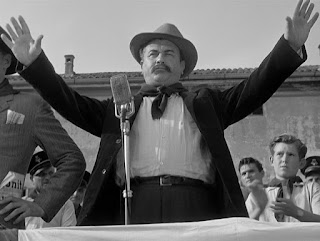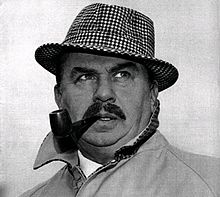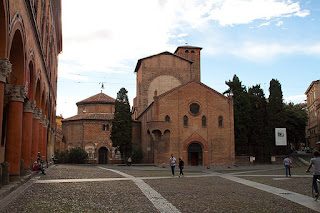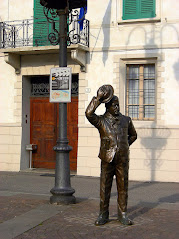Star remembered for groundbreaking moments in Italian cinema history
_Clara_Calamai_(3).png) |
| Clara Calamai enjoyed huge popularity with Italian cinema audiences in the '30s and '40s |
Calamai’s career is generally seen to have peaked with her appearances in Luchino Visconti’s 1943 crime drama Ossessione and, three years later, in Duilio Coletti’s melodrama L’adultera, for which she won a Nastro d’Argento award as best actress.
She scaled down her career drastically after marriage but won fresh acclaim three decades later for her role as Marta, a murderous ageing actress in ‘Master of Horror’ Dario Argento’s box office smash Profondo Rosso.
For many years, Calamai was also known as the first woman to bare her breasts in Italian cinema - in a 1942 movie that not surprisingly caused scandal at the time - although it was later accepted that another actress, Vittoria Carpi, had beaten her to that claim to fame.
Calamai, sometimes known as Clara Mais, was born in the Tuscany city of Prato, about 25km (16 miles) northwest of Florence, in 1909. She had two sisters, Vittorina and Paola, yet little is known about her early life before her big screen debut in Aldo Vergano’s 1938 historical epic, Pietro Micca.
She made a good living by accepting multiple parts in what then was a somewhat sanitised Italian film industry, which was regulated so tightly within the guidelines set by the Fascist authorities that approved film-makers were limited mainly to lightweight comedies and heroic costume dramas.
 |
| Calamai in La Cena delle Beffe, a film largely remembered for her 'nude' scene |
Despite the furore, the episode did no harm to Calamai’s career and her popularity maintained its upwards trajectory, putting her on a par with actresses such as Alida Valli and Valentina Cortese. It later transpired that Blasetti had already shown Vittoria Carpi's naked breast the previous year in La corona di ferro, although because Carpi was a young comparatively unknown actress, it attracted much less attention.
Indeed, the publicity generated may have helped Calamai land her most famous role, in 1943, when Visconti chose her to replace Anna Magnani, who was pregnant, in Ossessione, his debut film.
Co-written as well as directed by Visconti, the film was an adaptation of the 1934 novel, The Postman Always Rings Twice, by the American author, James M Cain. It was the second of seven adaptations of Cain’s novel, although Visconti’s - controversially - was not authorised or even credited.
The film was condemned by the Fascist regime for its unvarnished depictions of Italy’s working class population. But Calamai’s performance as Giovanna, who embarks on an affair with a young hobo and is eventually persuaded to murder her husband, was outstanding and the film is regarded today as a pioneering work of Italian cinema, perhaps the first neorealist film.
 |
| Calamai and co-star Massimo Girotti in a scene from Luchino Visconti's 1943 drama Ossessione |
The year before L’adultera’s success, Calamai had married Leonardo Bonzi, a former Italian tennis champion who also competed in bobsleigh at the Olympics. A qualified pilot, Bonzi was from noble stock and could call himself a count, if he so wished. They met when he embarked on a career in film directing and producing.
With the arrival of the first of their two children, Calamai severely limited her acting commitments, taking parts only sporadically. She and Bonzi divorced in 1961, after which she began to accept invitations from directors she favoured. Her playing of a prostitute in Visconti’s Le notti bianchi reminded cinemagoers of her acting ability. She appeared on television, too, in a Rai adaptation of Henry Fielding’s 18th century novel, Tom Jones.
What turned out to be her final film was hailed as one of her finest. Cast as Marta, an eccentric multiple killer, Calamai’s performance in Dario Argento’s 1975 hit Profondo Rosso - Deep Red - turned her into something of a cult figure among fans of the director’s work. Argento would later describe the film, which starred David Hemmings as the musician who ultimately identified Marta as the murderer, as his greatest work.
Profondo Rosso kept Calamai in the public eye for a number of years but eventually she disappeared from view. After living alone in her home in Rome not far from Termini station, she spent her final years in Rimini, where her sister, Vittorina, had lived since starting a family.
She died there at the age of 89, reportedly following a heart attack. She is buried at the Cimitero Monumentale di Rimini, where the Emilia-Romagna resort’s greatest cinema icon, Federico Fellini, was laid to rest alongside his wife, the actress Giulietta Masina.
 |
| The Palazzo Pretorio is one of Prato's notable buildings |
Prato, a city of just under 200,000 inhabitants, is less than 20 minutes by train from Florence, yet Clara Calamain’s home city is something of an overlooked gem among Tuscany's many attractions. Prato is the home of the Datini archives, a significant collection of late mediaeval documents concerning economic and trade history, produced between 1363 and 1410, as well as many artistic treasures, including frescoes by Filippo Lippi, Paolo Uccello and Agnolo Gaddi inside its Duomo, which has an external pulpit by built by Michelozzo and decorated by Donatello. The Palazzo Pretorio is a building of great beauty, situated in the pretty Piazza del Comune, and there are the ruins of the castle built for the mediaeval emperor and King of Sicily Frederick II. Prato’s commercial heritage is founded on the textile industry and its growth in the 19th century earned it the nickname the "Manchester of Tuscany".
 |
| Rimini's Tempio Malatestiano has frescoes by Piero della Francesca and paintings by Giotto |
Rimini has become one of the most popular seaside resorts in Europe, with wide sandy beaches and plenty of hotels and restaurants. But it is also a historic town with many interesting things to see. One of Rimini’s most famous sights is the Tempio Malatestiano, a 13th century Gothic church originally built for the Franciscans but which was transformed on the outside in the 15th century and decorated inside with frescoes by Piero della Francesca and works by Giotto and many other artists. Rimini had a role in the unification of Italy in the 19th century. It was there that Joachim Murat, the brother-in-law of Napoleon and King of Naples, issued his Proclamation in 1815, calling for all Italians to unite into a single people and drive out foreigners, namely the Austrians, who occupied large parts of northern Italy at the time. Although Murat was almost certainly acting out of self-interest at the time - he had just declared war on Austria and desperately needed support - the Proclamation is often seen as the opening statement of the Risorgimento.
Also on this day:
1559: The birth of painter and architect Cigoli
1744: The birth of architect Giacamo Quarenghi
1960: The birth of controversial conceptual artist Maurizio Cattelan








